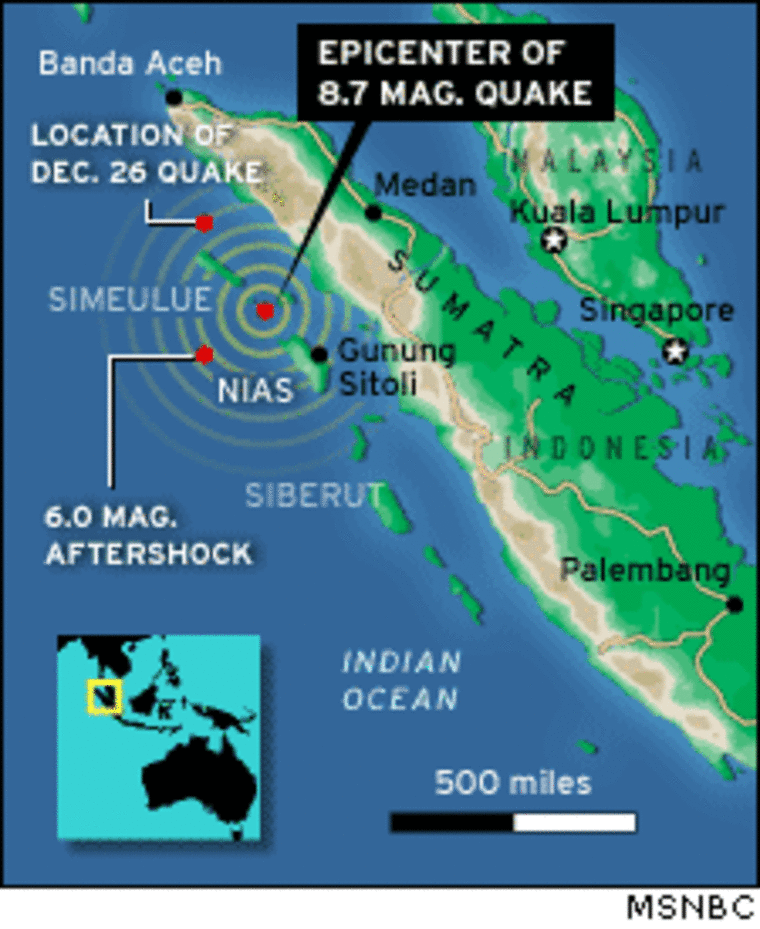Shaken into reaction by the deadly Dec. 26 tsunami, Indian Ocean states showed on Tuesday they were much better prepared to deal with the possibility of another killer wave following an earthquake off Indonesia.
In contrast to three months ago, when Asian nations were not even part of a tsunami warning network, the risk was immediately relayed by the Pacific Tsunami Warning Center in Hawaii and distributed across the region.
“We are happy with the alertness with which everyone woke up, all countries and all agencies,” said Mihir Bhatt of India’s Disaster Mitigation Institute in Ahmedabad.
Waves never come
Police, soldiers, monks, fishermen and ordinary residents of coastal areas across the Indian Ocean used megaphones, radio, telephones and temple bells to warn of the possibility of another tsunami following the 8.7 magnitude quake off Sumatra.
Thankfully the waves that left nearly 300,000 people dead or missing on Dec. 26 failed to materialize, but regional officials were quick to take credit for the apparent swiftness and smoothness of the reaction.
And while there were some reports of panic among people still deeply traumatized by last year’s tsunami, the overall reaction was clearly “better safe than sorry.”
In Banda Aceh, hardest hit last year, panicked residents rushed into the streets after Monday’s quake.
“We went down to the street and people began to panic. Some people screamed ‘Water! Water! The water is coming again’,” said Yudisia Arafah, a 23-year-old government worker in Aceh.
Elsewhere across the Indian Ocean, beach-front roads in major resort areas — where tourist numbers are still well down on last year — were clogged with traffic as residents and vacationers jumped in any available transport to evacuate to higher ground.
Tourists run for higher ground
On the tsunami-devastated paradise Thai island of Koh Phi Phi, made famous by the cult Leonardo diCaprio backpacker movie “The Beach,” bars emptied as word of a major earthquake spread by phone and word of mouth.
“My phone didn’t stop,” said Andrew Hewett, an adventure holidays operator.
“Everybody thought it better to be safe than sorry and made it to higher ground. At least we had a bit of information beforehand, which made people realize they should probably be doing something other than just sitting in a bar.”
Evacuation sirens began wailing on Sri Lanka’s tsunami-battered east coast within two hours of the earthquake, and police drove through coastal communities with loudhailers advising residents to flee inland.
Wary residents prepare to flee
All along Sri Lanka’s ravaged south, east and northern coastline, thousands of people packed a few possessions in plastic bags and cardboard boxes and sat by the main coastal roads trying to hail three-wheeler taxis or thumb lifts inland.
“When we heard the tsunami was coming, we ran to the top of the road,” said fisherman’s wife Krishanthi Perera, who lives in a wooden hut on the seafront on the outskirts of the capital, Colombo.
In India both authorities and coastal communities appeared better prepared and more aware of what to do this time.
People fled risk areas as soon as they saw or heard the first news flashes, and authorities quickly mobilized police and officials in vulnerable coastal areas.
Awareness prevents greater panic
J. Radhakrishnan, a senior official in Tamil Nadu where more than 6,000 people died in December tsunami, said there had been no panic.
“People are so used to the drill of evacuating beachfronts because of persistent rumors of tsunamis. In that sense, it was easy to get people away from the danger zones.”

Communities along Malaysia’s west coast, caught disastrously off guard last year, sprang into action after the latest quake.
Within an hour, Malaysian authorities had issued tsunami warnings telling people to head for higher ground. Police went from door to door raising the alarm, fishermen rushed to secure boat moorings and hotels put staff on standby to evacuate guests.
About 1,000 people fled their homes along the coast of northern Kedah state and on the resort island of Penang, in stark contrast to the ignorance shown on Dec. 26.
On that day, beachgoers watched bewildered as the sea rose. About 70 people died on Malaysian shores.
In Thailand, where nearly 5,400 people died in the Dec. 26 tsunami, officials used everything from megaphones and radio to telephone to get the message out, because a planned warning system is not yet installed.
“The cell phone service was completely overwhelmed by users scrambling to call families and friends,” Udomsak Asawarangkura, governor of the southern resort island of Phuket, told Bangkok radio.
“It turned out that the most useful channel was local C-Band radio. I came out on a local radio station and my deputy also went on TV to warn people.”